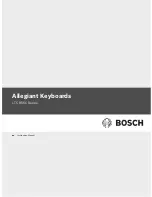
86
Creating a Performance
[3 (Pitch)]
fig.06-21_50
For details on the setting, refer to
“Adjusting the Parameters of
Each Part”
(p. 84).
Part Octave Shift
Adjusts the pitch of the part’s sound up or down in units of an
octave (+/-3 octaves).
Value:
-3– +3
Note that when a rhythm set is assigned to a part, if the Octave Shift
parameter is set, the rhythm tone that is played also changes.
Part Coarse Tune
Adjusts the pitch of the part’s sound up or down in semitone steps
(+/-4 octaves).
Value:
-48– +48
Part Fine Tune
Adjusts the pitch of the part’s sound up or down in 1-cent steps (+/-
50 cents).
Value:
-50– +50
One cent is 1/100th of a semitone.
Part Mono/Poly
Set this parameter to “MONO” when the patch assigned to the part
is to be played monophonically, or to “POLY” when the patch is to
be played polyphonically. When using the setting of the patch
assigned to each part (p. 49), set this to “PAT.”
Value:
MONO, POLY, PAT
For the part to which the rhythm set is assigned, this setting is
ignored.
Part Legato Switch
You can add legato when performing monophonically. Legato is a
playing style in which the spaces between notes are smoothed, creating a
flowing feel with no borders between the notes. This creates a smooth
transition between notes, which is effective when you wish to simulate
the hammering-on and pulling-off techniques used by a guitarist.
Turn this parameter “ON” when you want to use the Legato feature
and “OFF” when you don’t. When using the setting of the patch
assigned to each part (p. 58), set this to “PAT.”
Value:
OFF, ON, PAT
For the part to which the rhythm set is assigned, this setting is
ignored.
Part Pitch Bend Range
Specifies the amount of pitch change in semitones (2 octaves) that
will occur when the Pitch Bend Lever is moved. The amount of
change when the lever is tilted is set to the same value for both left
and right sides. When using the setting of the patch assigned to each
part (p. 49), set this to “PAT.”
Value:
0–24, PAT
Part Portamento Switch
Specify whether portamento will be applied. Turn this parameter
“ON” when you want to apply Portamento and “OFF” when you
don’t. When using the setting of the patch assigned to each part (p.
59), set this to “PAT.”
Value:
OFF, ON, PAT
Part Portamento Time
When portamento is used, this specifies the time over which the
pitch will change. Higher settings will cause the pitch change to the
next note to take more time. When using the setting of the patch
assigned to each part (p. 59), set this to “PAT.”
Value:
0–127, PAT
For the part to which the rhythm set is assigned, this setting is
ignored.
Coarse Tune and Octave Shift
The Coarse Tune and Fine Tune parameters, along with the Octave
Shift parameter, can all be seen as doing the same thing to the
sound, i.e., changing the pitch of the sound. For example, if C4
(Middle C) is played with the Coarse Tune parameter set to “+12,”
the note produced is C5 (one octave above C4). For example, if C4
(Middle C) is played with the Octave Shift parameter set to “+1,”
the note produced is C5 (one octave above C4).
However, internally these function very differently. When the
Coarse Tune parameter is set to “+12,” the pitch itself is raised one
octave. On the other hand, when the Octave Shift parameter is set
to “+1,” it is the same as pressing the keys one octave up. In other
words, use the Coarse Tune parameter when changing the pitch,
and the Octave Shift parameter when you want to shift the entire
keyboard, for example, when the number of keys is insufficient.
Reference_e.book 86 ページ 2003年7月14日 月曜日 午後3時25分
















































